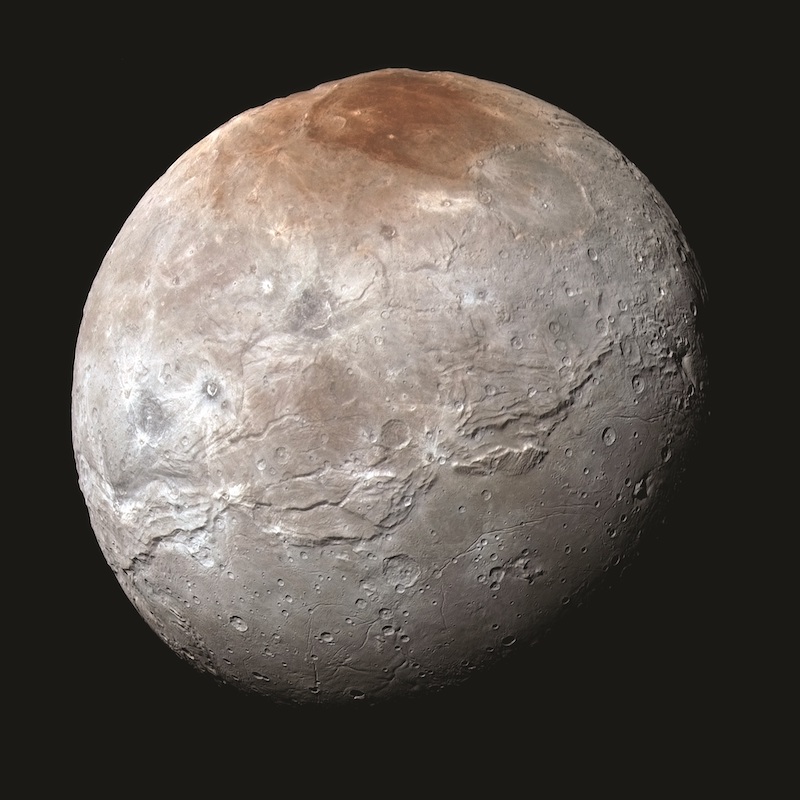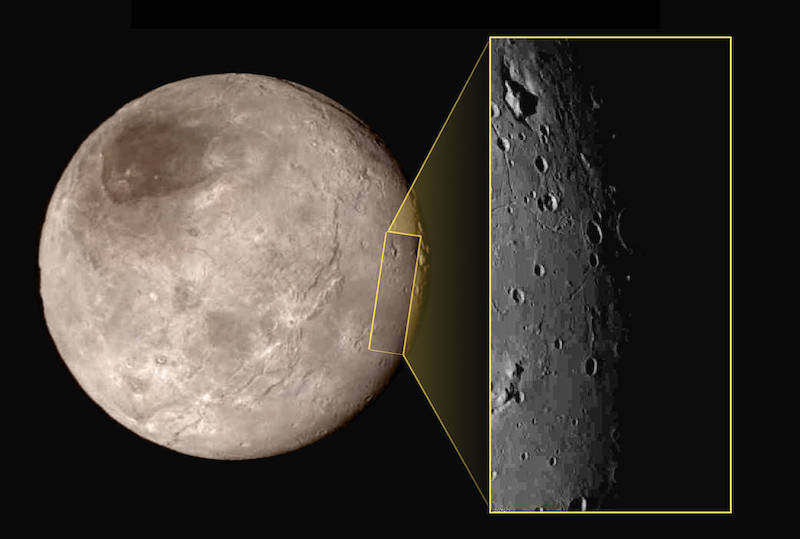
Charon is the largest of Pluto’s five moons. NASA’s New Horizons spacecraft first saw this intriguing world up close, when it flew past Pluto in 2015. The moon has craters, deep valleys and a bizarre isolated mountain that looks like it is sitting inside a moat. And there’s another odd feature on Charon: a large red “cap” at the moon’s North Pole. It’s reminiscent of an ice cap, except it’s, well, red. On June 21, 2022, scientists at the Southwest Research Institute (SwRI) in San Antonio, Texas, said they think they know how it formed.
Basically, they explain how a combination of seasonal “atmospheric surges” in Charon’s very thin atmosphere, ultraviolet radiation and methane form the distinctive red marking.
The researchers detailed their findings in two new papers. They published the first paper in the peer-reviewed journal Geophysical Research Letters (GRL) on April 15, 2022. And they published the second on June 17, 2022, in the peer-reviewed journal Science Advances.
Charon’s red cap
The images from New Horizons revealed the puzzling cap for the first time. It looked rather unusual on the otherwise mostly grey surface. Randy Gladstone, a member of the New Horizons science team, stated:
Prior to New Horizons, the best Hubble images of Pluto revealed only a fuzzy blob of reflected light. In addition to all the fascinating features discovered on Pluto’s surface, the flyby revealed an unusual feature on Charon, a surprising red cap centered on its North Pole.
So what caused it? Data from New Horizons showed it was likely composed of reddish tholins. Tholins are sticky organic residues formed by chemical reactions powered by light. Scientists theorized that it was the result of methane molecules being broken down by ultraviolet light from the sun. The molecules originate from Pluto and freeze on Charon’s surface at the moon’s North Pole. In the case of Charon, the light is the Lyman-alpha line ultraviolet glow scattered by interplanetary hydrogen atoms.

Seasonal surges in atmosphere create Charon’s red cap
Another key factor in the formation of the cap is Charon’s atmosphere. It is extremely thin, but still experiences seasonal changes. As described in the GRL paper:
Charon’s exosphere may exhibit extreme seasonal dynamics, with centuries of quiescence punctuated by short lived (about four earth years) exospheric surges near the equinoxes, as spring sunrise bi-annually drives frozen methane off the polar night zones.
The tholins freeze on Charon’s surface during the long winter nights. Ujjwal Raut, lead author of the Science Advances paper, said:
Our findings indicate that drastic seasonal surges in Charon’s thin atmosphere as well as light breaking down the condensing methane frost are key to understanding the origins of Charon’s red polar zone. This is one of the most illustrative and stark examples of surface-atmospheric interactions so far observed at a planetary body.
Replicating conditions on Charon
In order to determine how the red cap likely formed, the researchers replicated the conditions found on Charon’s surface in a lab. They conducted the experiments at SwRI’s new Center for Laboratory Astrophysics and Space Science Experiments (CLASSE). The researchers’ primary goal was to measure the composition and color of hydrocarbons produced on Charon’s winter hemisphere as methane freezes beneath the Lyman-alpha glow. The researchers used a new atmospheric model of Charon to analyze the measurements.
Indeed, they found evidence for methane turning into a tholin-like residue on Charon’s North Pole. As Raut explained:
Our team’s novel ‘dynamic photolysis’ experiments provided new limits on the contribution of interplanetary Lyman-alpha to the synthesis of Charon’s red material. Our experiment condensed methane in an ultra-high vacuum chamber under exposure to Lyman-alpha photons to replicate with high fidelity the conditions at Charon’s poles.

Charon’s thin methane atmosphere
In another model, the researchers simulated the moon’s thin methane atmosphere. This is how the seasonal surges were discovered. According to Ben Teolis, lead author of the GRL paper:
The model points to ‘explosive’ seasonal pulsations in Charon’s atmosphere due to extreme shifts in conditions over Pluto’s long journey around the sun.
Methane and ethane
As the methane deposits decompose at Charon’s North Pole, they release ethane as a by-product. Ethane itself is colorless, but the scientists say that on Charon, ionizing radiation from the solar wind turns it reddish. Ethane also remains frozen longer than methane. Raut said:
We think ionizing radiation from the solar wind decomposes the Lyman-alpha-cooked polar frost to synthesize increasingly complex, redder materials responsible for the unique albedo on this enigmatic moon. Ethane is less volatile than methane and stays frozen to Charon’s surface long after spring sunrise. Exposure to the solar wind may convert ethane into persistent reddish surface deposits contributing to Charon’s red cap.


From the GRL paper:
Ethane, the primary methane photoproduct under these conditions, may, unlike methane, remain frozen decades after polar sunrise under solar wind exposure. Solar wind radiolysis of polar ethane frost synthesizes higher-order refractories that may contribute to the coloration of Charon’s polar zones.
Scientists have, it seems, solved the mystery of Charon’s bright polar cap. That weird mountain in a moat still needs an explanation, though.
Bottom line: An odd reddish polar cap on Pluto’s moon Charon has puzzled scientists since first seen in 2015. Now researchers may have solved the mystery of Charon’s red cap.
Source: Extreme Exospheric Dynamics at Charon: Implications for the Red Spot











